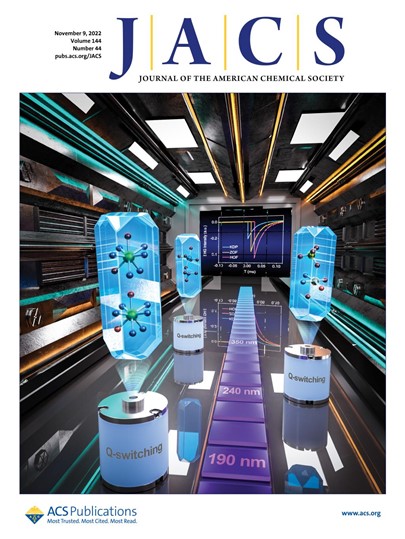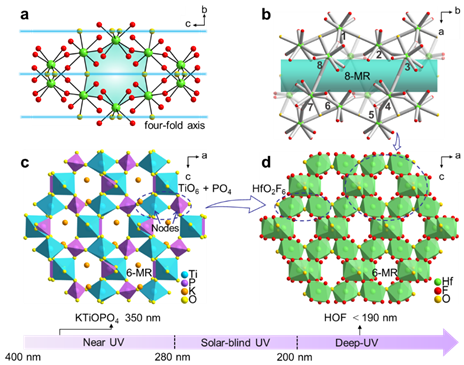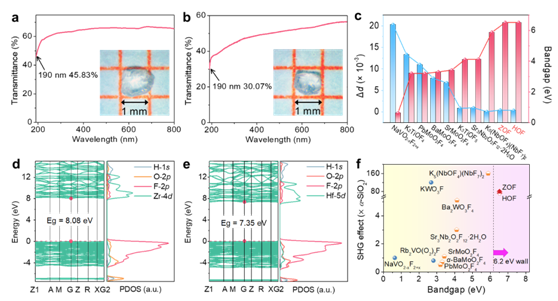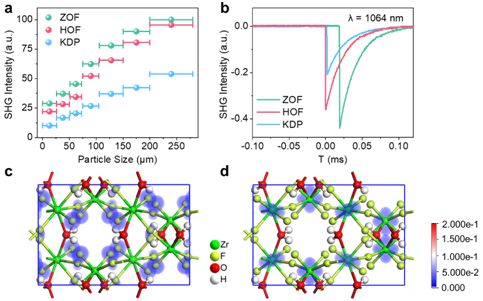
Zhang Chi's research team published an article in the Journal of the American Chemical Society
Zhang Chi's research team realized the strong second harmonic generation for the first time in deep ultraviolet transition metal oxyfluoride. Deep ultraviolet (λ < 200 nm) second-order nonlinear optical materials have great practical applications in high-power ultrashort pulse laser output, entangled photon source preparation, short-wave communication, 193 nm lithography, and vacuum ultraviolet laser angle-resolved photoelectron spectrometer. They are the technological bottlenecks of advanced laser manufacturing technology. At present, the reported and commercialized deep-ultraviolet nonlinear optical crystals are difficult to meet the needs of high-efficiency conversion of ultraviolet wavelengths, especially deep ultraviolet wavelengths, due to their structural defects or phase mismatch, which greatly hinders the rapid development of modern laser crystal technology and its practical applications in high-tech fields. Therefore, it becomes a challenging problem in high-performance optical materials and modern optical communication to develop second-order nonlinear optical crystal materials with a wide light transmission range in the ultraviolet band, large frequency doubling effect, and phase matching.
The research team of Professor Zhang Chi from the School of Chemical Science and Engineering of Tongji University, a fellow of the European Academy of Sciences, focused on the research of d0 transition metal oxyfluoride and proposed an approach of "equal network molecular design.” They developed the first d0 transition metal oxyfluoride crystalline material MOF4H2 (M = Zr (ZOF), Hf (HOF)) with the deep ultraviolet transmission. They explored the physical mechanism that the oxyfluoride achieved a synchronous gain of band gap and frequency doubling effect. Their discovery on "Isochemical Design of KTiOPO4-like Deep-Ultraviolet Transparent Materials Exhibiting Strong Second-Harmonic Generation" was published in the Journal of the American Chemical Society (November 10, 2022, 144 (44), 20394-20399), and was selected as the cover article of the latest issue of the journal by JACS Editorial Board for the original research work and the recognition of domain experts.

Strong second-harmonic generation is realized for the first time in deep ultraviolet transition metal oxyfluoride
In this study, the research team put forward the approach of "equal network molecular design" for the first time, by taking the famous commercial second-order nonlinear optical crystal KTiOPO4 (KTP) as the structural model. By changing the types of transition metal polyhedral units of functional network nodes in the KTP three-dimensional structure, the d0 transition metal central unit [MO2F6] (M = Zr, Hf) with low effective electronegativity replaces [TiO6] and [PO4] in classical KTP structure, thus creating the first d0 transition metal oxyfluoride ZOF and HOF with KTP-like structure configuration. Compared with the transition metal [TiO6] polyhedral unit, the transition metal zirconium/hafnium cation center unit in ZOF and HOF has a higher oxygen-fluoride ratio. Likewise, compared with high valence transition metal polyhedra, tetravalent d0 transition metal zirconium/hafnium cation has lower effective electronegativity, which can effectively hinder the charge transfer of oxygen/fluorine-metal in metal polyhedra. Introducing fluorine atoms with the greatest electronegativity into this kind of metal polyhedron and increasing the F/O ratio in the metal polyhedron as much as possible will significantly change the electronic band structure of the material, which provides a great possibility for the blue shift of its ultraviolet absorption cut-off edge. Especially, the long-range ordered microscopic arrangement of d0 transition metal center polyhedron is beneficial to the material showing a strong second harmonic effect.

The approach of "equal network molecular design" is put forward for the first time
The research team used X-ray diffraction analysis of a single crystal structure combined with first-principles theory for analog calculation. They found that the maximum gain of the band gap in ZOF and HOF can be attributed to the high fluorination of d0 transition metal polyhedron [MO2F6] (M = Zr, Hf) and the low electronegativity of the metal center. Experimental results show that ZOF and HOF have good physicochemical stability, and their UV absorption cutoff edges are less than 190 nm. The oxyfluoride exhibits a strong powder frequency doubling response (2.2 × KDP (ZOF) and 1.8 × KDP (HOF)) at 1064 nm wavelength, and can realize phase matching. This research is significant in creating and developing new high-performance deep ultraviolet second-order nonlinear optical crystalline materials.
In 2022, Zhang Chi's research team made important progress in developing oxide second-order nonlinear optical crystals. Their research results were published in issues of German Applied Chemistry (Angewandte Chemie) this year. They put forward the approach of "cation synergistic compensation,” which effectively improved the frequency-doubling effect of sulfate crystalline materials. Their discovery of "A Lanthanum Ammonium Sulfate Composite Salt with Strong Frequency Doubling Response and Wide and Deep Ultraviolet Transmission" was published in Angewandte Chemie International Edition (2022, 61 (6), e202115855, Hot Paper). They also proposed a design method for optimizing the arrangement of fluorine-rich metal central polyhedrons to improve the nonlinear optical performance. A paper based upon this research entitled "Ultra-wide energy band and strong second harmonic response of transition metal oxide fluoride nonlinear optical materials" was published in Angewandte Chemie International Edition (2022, 61 (26) e202203104, Inside Cover). They revealed the crystalline phase transition mechanism of iodate and discovered that its metastable phase had a strong second harmonic effect. A paper based on this research entitled "Reaction Promoter Triggered Polar Polymorphism Formation: β-Sc (IO3) 3, a Potential next Generation Mid-infrared Nonlinear Optical Material" was published in Angewandte Chemie International Edition, 2022, 61 (36), e202208514).

X-ray diffraction analysis of single crystal structure combined with first-principles theory is used for analog calculation
The research was supported by NSFC, the Innovation Team Scheme of the Ministry of Education, the Ministry of Science and Technology, the Talent Introduction Plan of the MOE Administration of Foreign Experts Affairs, and the Science and Innovation Plan of the Shanghai Municipal Education Commission. ZHANG Chi is the paper’s corresponding author, and JIANG Chunbo, a doctoral candidate, and Associate Professor WU Chao are the co-first authors of the paper. Professor HUANG Zhipeng participated in the relevant research work. They are all from the School of Chemical Science and Engineering.
Article link: https://pubs.acs.org/doi/10.1021/jacs.2c08403? Ref=pdf
HYPERLINK "https://pubs.acs.org/doi/10.1021/jacs.2c08403?ref=pdf"